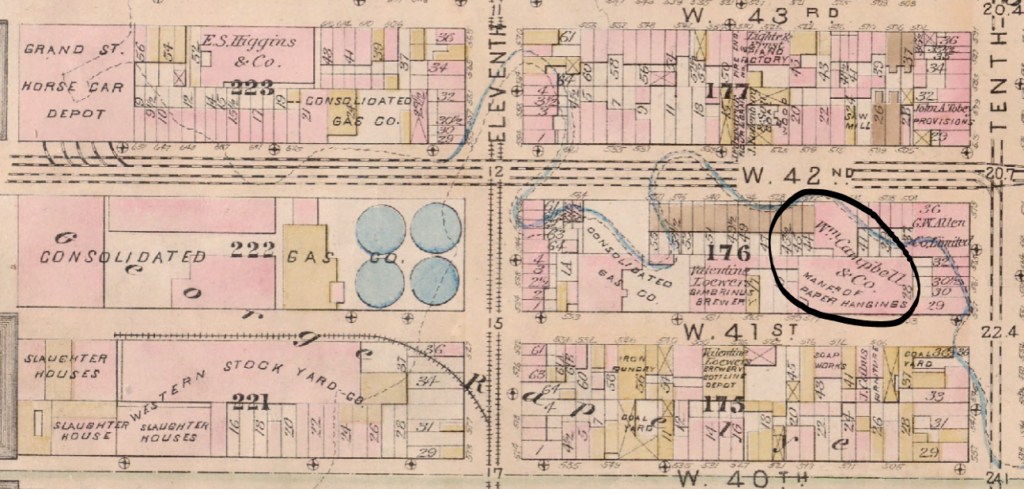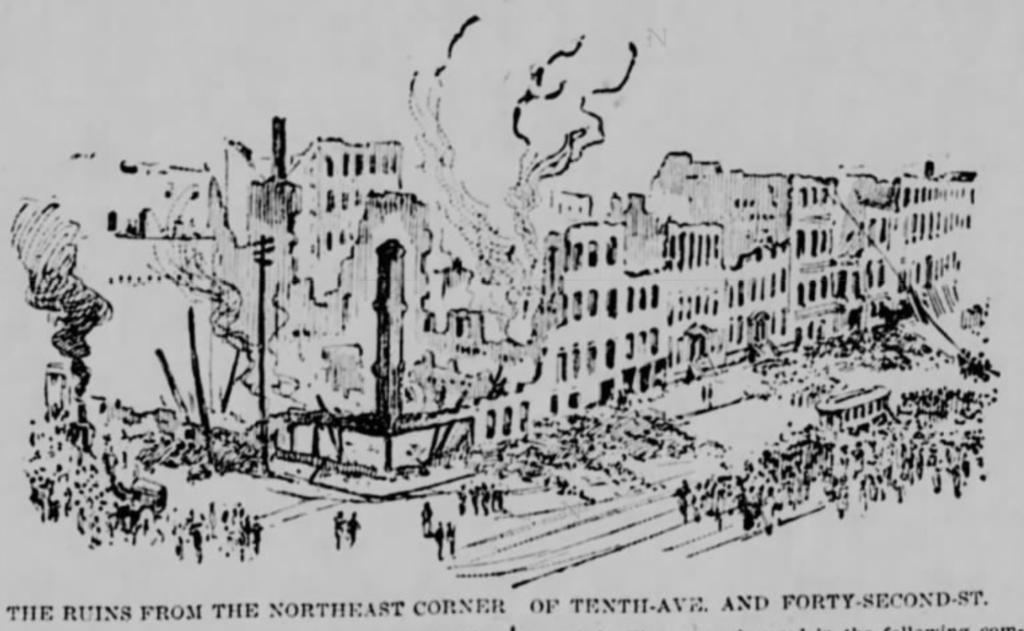The following dog story of Old New York, taken from the pages of the New York Times and an old book published in 1922 (Dog Heroes of Many Lands by Sarah Nobel Ives) is about a fireman named James MacMurray and his life-saving fire dog, Robert Bruce. Despite countless hours of searching, I cannot determine which midtown (I assume) engine company they were assigned to. Perhaps someone can help me solve this mystery…

When James MacMurray left his position as herdsmen of a large New Jersey stock farm in 1893 to become a member of the New York Fire Department, he brought along his constant companion, Robert Bruce, a well-trained black and tan “sheep dog.” The two-year-old collie was trained to herd sheep, so he had a lot to learn about herding fire horses in city traffic.
“You’ll not find a better,” the tall, red-headed man told the captain of the engine company. “Bruce has been with me upwards of two year, and a finer herder you’ll not find in New Jersey.”
It took him some time to get used to the noise and traffic, but pretty soon, Robert Bruce MacMurray was an official FDNY fire dog. Every evening he sat with the men in their sitting room on the top floor of the engine house, where they would tell stories, read, or play cards. He’d also help out to make sure the horses were properly rubbed down, groomed, and fed each day.
Robert Bruce always slept at the foot of MacMurray’s bed, and when the fire alarm clanked out its warning, he was down the stairs before the fastest fireman could slide down the pole. He would go to all the fires and gallop under the engine. Swift of foot and sure of eye, he never got in the way of firemen’s feet or horses’ hooves.
Twice during his first winter with the FDNY, Robert Bruce was responsible for saving lives. In the first incident he saved the lives of his beloved fire horses, and in the second event, he came to the rescue of his loving master.
The William Campbell Paper Factory Fire

At approximately 8 p.m. on October 18, 1893, James Sexton, a watchman for the William Campbell paper factory on 41st Street and 10th Avenue, was on one of the upper floors of the eight-story brick building when he saw flames coming from the adjacent Nevius & Haviland wall-paper factory.
Soon the fire spread to Campbell’s factory, causing Sexton to lose consciousness near a door on the ground floor. Fortunately, a police officer also saw the flames and was able to drag Sexton out the building before pulling the fire alarm.
Flames were bursting from the windows of both factories by the time the first of many fire companies arrived. In their rush and excitement, the firemen of Robert Bruce’s company forgot about the horses. Even fireman Pete Tinkum, who drove the engine that night, did not notice that the fire was beginning to spread at the corner of the block where his horses stood.
Since it was the dog’s job to stay with the engines during the fires, Robert Bruce was the first to notice the horse nearest the flames succumb to the heat and collapsed. He jumped from firemen to fireman to get their attention, but they were too occupied to pay the dog any mind. Finally, he jumped on Pete, who followed the frantic dog to the engine and saved the other horses just in time before they also suffocated.


Bruce’s second heroic feat came soon after the factory fire, during a smoky fire at a tenement house on 20th Street. This fire filled the building with dense smoke, which made it very difficult for the firemen to find and rescue those residents who stayed inside and didn’t climb down the gutter spouts, hurl themselves from windows into nets, or fall to their deaths.

James MacMurray and his partner, Fireman Cummings, were groping their way along the hallway of a second-floor landing when MacMurray grabbed for a broken railing. Unbeknownst to Cummings, MacMurray stumbled and fell, landing under a staircase, where he lay barely conscious, stunned, and alone.
When they realized he was missing, Captain Warner and Cummings started searching through the building, but they couldn’t find him. They were just about to go for a ladder to get into the third floor when they heard Bruce barking inside. The dog appeared at the door and led the men to James.
The Livery Fire of 1899
Robert Bruce MacMurray’s greatest save came during the Great Blizzard in January 1899.
Following a day of constant alarms, another alarm for a fire at a large livery stable near Madison Avenue came in just after the men had finally gotten to bed. Because of the extreme cold and dangerous ice conditions, MacMurry ordered Robert Bruce to “bide at home.”
But the fire dog could not stay back and miss the action, so he took off after the engine. MacMurray spotted him on the fire scene, but he was too busy trying to put out the fire and save the 35 horses inside to reprimand his dog.

With the water freezing as soon as it sprayed from the hoses, the firemen knew they could not save the barn. So instead, they focused on leading the horses out of the burning building one by one. Panic seized the horses as they were led out, and they all returned to the stables, where the smoke was too dense for the firemen to rescue them again.
Suddenly, the former sheep-herding dog ran into the flames. “Hold your wits and look!” MacMurray told the worried men.
“Look, man, don’t you see the bonny laddie? He’s herdin’ them! He’s a herdin’ the horses like sheep, and they dare not disobey. He’s bitin’ their heels now. Look how they mind him!”

As a large crowd of firemen and civilians watched in awe, Bruce kept biting at them, jumping on them, and nipping at them to keep the horses from returning to the stable. The horses ran down the street toward Madison Avenue until Bruce herded them onto another side street. He held them against the wall of a brewery until the stable hands were able to lead them to shelter in other stables.
That evening, Robert Bruce MacMurray saved the lives of 20 horses.
The following week a delivery truck arrived at the firehouse with a package addressed to Robert Bruce MacMurray.
Inside was a leather box lined with satin that held a magnificent dog collar with a plate of solid gold tacked onto it that read: “Robert Bruce MacMurray, The Fire Dog, In grateful remembrance of services rendered on the night of January 27, 1899. From (owner) to the dog who saved the lives of twenty horses.”
If you enjoyed this tale, you may enjoy reading about the cat-saving fire dog of Brooklyn’s Engine Company No. 203.



Robert Bruce MacMurray was a hard worker and obviously loved his job. Thank you for the post!